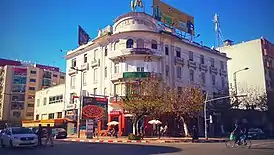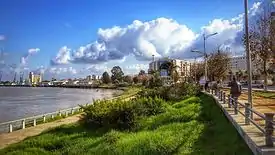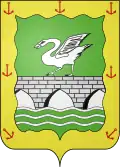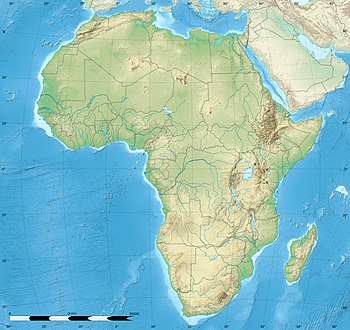Kenitra
Kenitra (Arabic: القنيطرة, romanized: al-qunayṭira, lit. 'the little bridge'; Berber languages: ⵇⵏⵉⵟⵔⵇ, romanized: Qniṭra) is a city in northwestern Morocco, formerly known as Port Lyautey from 1932 to 1956. It is a port on the Sbu river, has a population in 2014 of 431,282,[2] is one of the three main cities of the Rabat-Salé-Kénitra region and the capital of Kenitra Province. During the Cold War Kenitra's U.S. Naval Air Facility served as a stopping point in North Africa.
Kenitra
| |
|---|---|
      Avenue Mohamed Diouri, Avenue Mohamed V, Kenitra | |
 Seal | |
 Kenitra Location in Morocco  Kenitra Kenitra (Africa) | |
| Coordinates: 34°15′N 6°35′W | |
| Country | |
| Region | Rabat-Salé-Kénitra |
| Province | Kenitra |
| Founded | 1912 |
| Government | |
| • Mayor | Aziz Rabbah (PJD) (2009) |
| Area | |
| • Total | 672 km2 (259 sq mi) |
| Elevation | 26 m (85 ft) |
| Population (2014)[1] | |
| • Total | 431,282 |
| • Rank | 9th in Morocco |
| Time zone | UTC+1 (CET) |
| Website | http://www.alkenitra.com/ |
History
Ancient history
The history of the city begins with the foundation of a trading-post by the Carthaginian, known back then as Thamusida. Under the Antonine dynasty, a Venus temple was built there.
Before the French protectorate, there was only Kasbah Mahdiyya in the area where the modern city can today be found.
Colonial and recent history
In March 1912 the French government and the Sultan of Morocco, Abd al-Hafid, signed the Treaty of Fez. Because of his growing unpopularity, the Sultan asked the French government for protection against the Berber rebel tribes surrounding Fez. France appointed Hubert Lyautey resident-general in Morocco.
General Lyautey restored peace and order to the country after crushing the tribal uprising. After safely moving the Sultan from Fez to the current capital city, Rabat, Lyautey began his task of civilian administration.

One of the first preoccupations of General Lyautey was to build ports along the inhabitable Atlantic coast where there were no natural harbors. He established Kenitra in 1912 as a French military fort and town. The port at Kenitra, at the mouth of the Sebou river, was opened in 1913.[3] It soon became the best river port in Morocco.[4] Kenitra draws its name from a culvert built at Fouarat lake upstream of the kasbah. This culvert was destroyed in 1928. In 1933, the French officially named the locale "Port Lyautey".
It was renamed "Quneitra" in 1956 as Morocco gained its independence. Quneitra has grown rapidly to be a shipping centre for agricultural produce (mainly fruit), fish, timber, and lead and zinc ores. The city's industrial area lies upstream of the port.
U.S. Naval Base

In November 1942, after Operation Torch, the Americans captured the Port Lyautey French fighter base as a military base, named Craw Field. For three months the 21st Engineer Aviation Regiment worked on the airfield. In Feb. 1943 the Seabees of the 120th Naval Construction Battalion took over all construction activities.[5] The Navy ran the base until 1947, when the State Department negotiated reversion of control to France. In 1950, a $23,000,000 expansion was authorized, but then the Korean War diverted resources. In the 1950s, nearly 10,000 persons were on the base making it the largest aggregation of Americans in any one overseas base outside Japan. Later, the base at Kenitra was expanded to become a U.S. Naval Air Station.[6]
The base was shared by both the US and Morocco through the Cold War. A small Navy communications out-station at Sidi Yahia closed in the late 1970s. The Air Station was closed in 1991.
Climate
Kenitra has a hot-summer Mediterranean climate (Köppen climate classification Csa).
| Climate data for Kenitra | |||||||||||||
|---|---|---|---|---|---|---|---|---|---|---|---|---|---|
| Month | Jan | Feb | Mar | Apr | May | Jun | Jul | Aug | Sep | Oct | Nov | Dec | Year |
| Average high °C (°F) | 17.3 (63.1) |
18.1 (64.6) |
19.5 (67.1) |
20.6 (69.1) |
22.8 (73.0) |
24.8 (76.6) |
27.4 (81.3) |
27.9 (82.2) |
27.1 (80.8) |
24.7 (76.5) |
21.1 (70.0) |
18.0 (64.4) |
22.4 (72.3) |
| Daily mean °C (°F) | 12.3 (54.1) |
13.3 (55.9) |
14.4 (57.9) |
15.7 (60.3) |
18.1 (64.6) |
20.6 (69.1) |
23.0 (73.4) |
23.3 (73.9) |
22.2 (72.0) |
19.4 (66.9) |
15.9 (60.6) |
13.0 (55.4) |
17.6 (63.7) |
| Average low °C (°F) | 7.2 (45.0) |
8.5 (47.3) |
9.3 (48.7) |
10.9 (51.6) |
13.4 (56.1) |
16.3 (61.3) |
18.6 (65.5) |
18.7 (65.7) |
17.4 (63.3) |
14.1 (57.4) |
10.7 (51.3) |
8.0 (46.4) |
12.8 (55.0) |
| Average precipitation mm (inches) | 97.6 (3.84) |
94.6 (3.72) |
74.9 (2.95) |
67.3 (2.65) |
37.8 (1.49) |
5.8 (0.23) |
0.4 (0.02) |
0.6 (0.02) |
10.7 (0.42) |
63.0 (2.48) |
130.0 (5.12) |
135.9 (5.35) |
718.6 (28.29) |
| Average precipitation days | 12.3 | 12.7 | 12.2 | 11.0 | 7.6 | 2.9 | 0.3 | 0.7 | 2.8 | 8.6 | 13.3 | 14.0 | 98.4 |
| Mean monthly sunshine hours | 165.0 | 170.4 | 229.8 | 255.8 | 296.7 | 302.9 | 326.5 | 312.8 | 263.8 | 227.2 | 174.6 | 161.4 | 2,886.9 |
| Source: NOAA[7] | |||||||||||||
Population
| 982 | 1994 | 2004 | 2010 | 2014 |
|---|---|---|---|---|
| 187,000 | 291,000 | 358,000 | 400,000 | 430,000 |
Areas and neighborhoods
- Mdina
- Khabazate
- The Cigogne
- La cite
- Modern city
- Mimosa
- Ville Haute
- Popular districts
- Saknia
- Wuled Oujih
- Maghrib al Arabi
- Residential districts
- Bir Rami
- Ismailia
- Val fleury
Education
Primary and secondary schools
There is a French international school, Groupe scolaire Honoré-de-Balzac, serving moyenne section through collège (junior high school).[9]
Colleges and universities
- Université Ibn-Tofail (UIT)[10]
- ENCG Kénitra (École nationale de commerce et de gestion de Kénitra)
- HECI Kénitra (Hautes Etudes Commerciales et Informatiques)
- ENSA Kénitra (École nationale des sciences appliquées de Kénitra)
Transportation
- The National Route 1 and the A1 motorway pass through Kenitra and connect it to Rabat-Salé in the south-west and to Larache in the north-east.
- The city is served by one railway station: Kenitra-Ville. A shuttle train, TNR, connects the city, every 30 minutes, to Rabat and Casablanca.
- A high-speed rail line to Tangier was completed in 2018.[11](See Kenitra–Tangier high-speed rail line.)
Sports
Kenitra Athletic Club, KAC
In 1938, a group of Kenitra natives created KAC.
This group of soccer lovers wanted to resist French domination in sports in Morocco.
The team, made entirely of Kenitra natives, succeeded in reaching the premier Moroccan soccer league in 1956. In 1960, KAC won its first championship league of Morocco. KAC embarked in a journey of glories by winning the 1973-81-82 championship leagues and the 1961 throne cup.
Ahmed Souiri was a long-time manager and coach. KAC has produced many international players.
Bouliahiaoui and Khalifa were among the players who helped the Moroccan national soccer team qualify for the second round of the World Cup finals in Mexico in 1986. Mohammed Boussati still holds a national record of goals by scoring 25 goals in one soccer championship season in 1981–82.
Its home is the Kenitra Municipal Stadium which has a capacity of 15,000 people.[12]
Basketball
The KAC Kénitra was a very successful basketball team during the 70s and 80s.
Natives from Kenitra
Kenitra was the birthplace of:
- Saïd Aouita, Olympic athlete
- Amina Aït Hammou, Olympic athlete
- Youssef Chippo, International football player
- Margie Cox, American R&B Singer
- Mohamed Sijelmassi, writer and physician
- David Bitan, Israeli politician
- Nayef Aguerd – Moroccan footballer
- Sofian Chakla – Moroccan footballer
See also
Notes and references
- "POPULATION LÉGALE DES RÉGIONS, PROVINCES, PRÉFECTURES, MUNICIPALITÉS, ARRONDISSEMENTS ET COMMUNES DU ROYAUME D'APRÈS LES RÉSULTATS DU RGPH 2014" (in Arabic and French). High Commission for Planning, Morocco. 8 April 2015. Retrieved 29 September 2017.
- "Population légale d'après les résultats du RGPH 2014 sur le Bulletin officiel N° 6354". hcp.ma (in Arabic). Retrieved 2015-07-11.
- Kénitra depuis 1912 Archived 2003-10-03 at the Wayback Machine (in French)
- In Morocco by Edith Wharton, New York: Charles Scribner's Sons 1920
- Port Lyautey, Chapter XX, The Mediterranean Area, Building the Navy's Bases in World War II, History of the Bureau of Yards and Docks and the Civil Engineer Corp, 1940-1946, Volume II, UNITED STATES GOVERNMENT PRINTING OFFICE, WASHINGTON, p. 80
- "History of Port Lyautey".
- "Kenitra Climate Normals 1961–1990". National Oceanic and Atmospheric Administration. Retrieved March 16, 2015.
- "Kenitra, Morocco Metro Area Population 1950-2020 – macrotrends.com". macrotrends.com.
- "Groupe scolaire Honoré-de-Balzac". AEFE. Retrieved June 16, 2016.
- . 6 February 2006 https://web.archive.org/web/20060206180040/http://www.uit.ac.ma//. Archived from the original on 6 February 2006. Missing or empty
|title=(help)CS1 maint: bot: original URL status unknown (link) - https://www.aljazeera.com/news/2018/11/africa-fastest-train-steams-morocco-181115165325722.html
- "Stade Municipal de Kénitra – StadiumDB.com". stadiumdb.com.
External links
| Wikimedia Commons has media related to Kenitra. |
